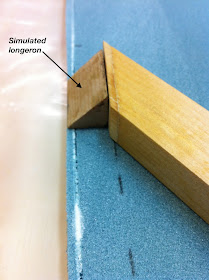Glassing the right fuselage side (8.5 hrs)
Coming home late the other night, I decided to sand the shaped, yet unfinished right sidewall, while standing it back to back with the finished left sidewall (bad idea). I figured I'd make them identical.
Unfortunately, due to my tired state, I sanded it at an angle and never noticed it (so predictable).
I woke up the next morning refreshed, and ready to glass the right side. Luckily, I took some time beforehand to double check the positioning of the gear mount, LWX, and LWY on the sidewall (second smart thing I did). Good thing I did, because nothing fit right anymore!
After shifting pieces around numerous times to no avail, I eventually measured the size of the sidewall every 10", and what I found was a bit shocking. I was missing 0.2" to 0.3" (5 to 8 mm) just about everywhere!
Initially, I couldn't figure out what had happened, then I remembered the late night sanding session, and I became furious with myself, and also a bit unsure about what to do next. I wanted so bad to proceed anyway, but the gaps were just too big. So, I took all the scraps I had saved (first smart thing I did), and glued them back to the bottom of the fuselage side.
 |
| Glueing foam scraps back onto the bottom of the sidewall |
 |
| Same thing seen from the other side |
I let them cure overnight, then basically started all over again by remeasuring the fuselage side, marking it, and cutting it one more time.
 |
| You can see how much foam I had to add back |
This mistake just set me back two days, but it goes to show two things:
First, you shouldn’t even think about touching the project when you are tired.
Second, this type of construction is very forgiving, and there is no reason to having to live with your mistakes, instead of fixing them.
Here’s one of the problems that were fixed by adding the missing foam...
 |
| The simulated longeron is glad it doesn't have to stick out of the bottom of the airplane anymore |
In this case part of my lower longeron would have been sticking out the bottom. Not cool!
Having solved the latest crisis, I moved on to glassing the right sidewall.
I was curious to try out the latest gadget... I mean, indispensable tool... I had picked up at LOWES a few days prior.
 |
| Cutting through UNI the lazy way |
At $28 it’s not cheap, but I will still be cutting hundreds of yards of fiberglass, and so far, none of the methods I’ve been using has been without problems.
The “pizza cutter” rollerblade method is pretty good, but the cutting edge quickly develops a few dull spots that leave a number of uncut strands with every pass, that are impossible to see. When you try to remove the cut piece, these individual uncut strands pull partially out of the weave, and also pull the weave out of shape. The solution is to slowly pull on the piece just enough to identify where it has not been cut, then use the “pizza cutter” over the same cut again. This is slow, tedious, and never ending, if you don’t follow the original cut precisely, since you will have just created another cut in the glass with identical problems.
The scissors method is cheap and definitive, but BID is so sensitive that the mere opening and closing of the scissor can sometimes deform the weave.
On the contrary, using the new tool, the cut edges of the glass are nicely sheared, and there is no up and down scissor-like motion to disrupt the cloth. This cutter has been working well enough so far to make me want to keep it around for more testing.
 |
| Nicely cut edges |
Pressing on!
As on the left side, I started slurrying the right sidewall.
 |
| Micro-slurry contagion spreading |
I then added dry-micro to fill some dents in the foam, and created a fillet in the joystick depression to help transition the UNI.
 |
| Looks like Meteor Crater in Arizona |
I had heard enough tales about what a pain it is to make the UNI conform to the side-stick cutout, that I decided to go overboard with the size of my fillet, in an effort to make the transition super-smooth.
 |
| Close up of Meteor Crater |
This effort really made laying the glass in the hole easy. I don’t want to jinx myself, but I think the UNI is down in there without any air bubbles.
 |
| Laying UNI at 30˚ |
As I mentioned while working on the left side, I decided to use a peel-ply sheet on the whole right side, rather than tape, in an effort to cut down on the evil loose peel-ply strands, that are in the habit of sticking to my work well after their time is up.
 |
| Peel-ply covering the entire sidewall |
I would say that working with the peel-ply sheet was very easy.
Sadly though, dozens of little epoxy bubbles did form under the peel-ply every time I left the shop. I think must have gone back at least three more times to squeegee them off the side of the piece, leaving a perfectly smooth surface every time, only to see them reappear later. I have no explanation for this behavior, I suppose I will just have to sand them back down after the peel-ply sheet is removed.
I didn’t take any pictures of them before I left, but I will in a few days, when I return home. Hopefully that is the only small issue I’ll have to deal with.



No comments:
Post a Comment